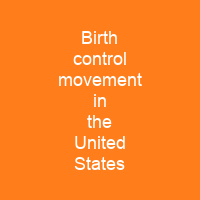The birth control movement in the United States was a social reform campaign beginning in 1914. The movement aimed to increase the availability of contraception in the U.S. through education and legalization. Margaret Sanger opened the first birth control clinic in 1916, but the clinic was immediately shut down by police. The widespread availability of. contraception signaled a transition from the stricter sexual mores of the Victorian era to a more sexually permissive society.
About Birth control movement in the United States in brief

The book suggested that family planning was a laudable effort, and that sexual gratification – without the goal of reproduction – was not immoral. The only known survey conducted during the nineteenth century of American women’s contraceptive habits was performed by Clelia Mosher from 1892 to 1912. The survey was based on a small sample of upper-class women, and shows that most of the women used contraception and that they viewed sex as a pleasurable act that could be undertaken without thegoal of procreation. Longstanding techniques included the rhythm method, withdrawal, diaphragms, contraceptive sponges, condoms, prolonged breastfeeding, and spermicides. The use of contraceptives increased throughout the nineteenthcentury, contributing to a 50 percent drop in the fertility rate in the US between 1800 and 1900, particularly in urban regions. The practice of birth. control was common throughout the US. prior to 1914, when the move to legalize contraception began. In the 1920s, public discussion of contraception became more commonplace and the term “birth control” became firmly established in the nation’s vernacular. In 1930, the American Medical Association in 1937 adopted contraception as a core component of medical school curricula, but women continued to rely on unsafe and ineffective contraceptive advice from ill-informed sources. By the 1950s, birth control practices were generally adopted in Europe and nearly all Western European countries, except Catholic Ireland, Spain, France and France, except for Ireland and France.
You want to know more about Birth control movement in the United States?
This page is based on the article Birth control movement in the United States published in Wikipedia (as of Nov. 16, 2020) and was automatically summarized using artificial intelligence.







